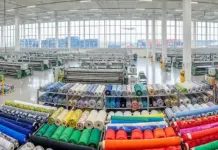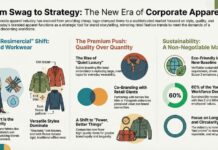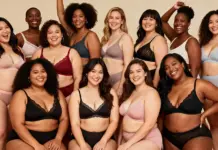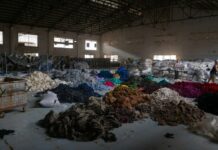Executives anticipated President Trump’s recent tariff announcement on April 2 would be damaging, but the reality turned out to be significantly worse than expected.
The newly dubbed “Liberation Day” tariffs, affecting $2.5 trillion in imports, prompted executives from US-based companies with overseas operations to spring into action. They held urgent board meetings and contacted suppliers in countries like Vietnam, Cambodia, and Bangladesh, which faced tariffs of 46%, 49%, and 37%, respectively. In response to the escalating situation, one US brand formed a “tariff task force,” comprising team members from sourcing, production, product development, merchandising, IT, and other critical areas. The stock market reacted negatively, with the S&P 500 losing a staggering $2.4 trillion in one day. Companies such as Nike, American Eagle, Gap, Ralph Lauren, and Tapestry experienced share price drops of up to 30%.
Conversations among brand executives were marked by chaos, uncertainty, and anxiety, with many opting to speak anonymously due to fears of retribution from the Trump administration for voicing concerns about the tariffs. Most fashion brands either declined to comment or referred inquiries to trade organizations like the National Retail Federation (NRF) and the American Apparel and Footwear Association (AAFA). “These tariffs are much higher than anticipated,” remarked Jonathan Gold, NRF’s Vice President of Supply Chain and Customs Policy. “The administration needs to recognize that this will have significant ramifications for retailers, particularly small ones that can’t pivot as swiftly. Concerns about business viability due to rising costs are being voiced. The downstream impact could lead to job losses and even business closures. Consumer confidence is already low, and these tariffs will exacerbate that.” The Trump tariffs impact US fashion significantly.
On March 31, the NRF released a survey indicating that 76% of US consumers were worried about how tariffs would affect prices, with 81% expressing fears about small business closures due to economic pressures.
For many brands, encountering tariffs as high as 54% on countries like China (the highest under the new policy) leaves them with little choice but to escalate prices—potentially by around 15% on average. Negotiations with vendors have increasingly focused on how much cost can be absorbed before reaching a breaking point, but overseas manufacturers already operate on razor-thin margins. Potential strategies to soften the impact on consumers include transparency about price hikes—specifically citing the tariffs—though there are concerns about provoking the administration’s ire. The Trump tariffs impact US fashion brands and their pricing strategies.
“This poses an existential threat. Everyone is holding their breath,” stated Sanjeev Bahl, CEO of Saitex, a denim manufacturer with operations in Vietnam and Los Angeles, while in Ho Chi Minh City at the time of the announcement. “Sourcing teams are actively exploring alternatives; calculations are underway. However, nobody has yet formulated a contingency plan until we have concrete numbers and potential negotiations.”
Some companies hope for negotiations to lower the tariff rates, leading them to hold back shipments ready for import to the US in an effort to avoid the new costs. However, this strategy can only be effective for a limited time before inventory becomes a concern. The ambiguity surrounding negotiation possibilities remains: while Trump indicated discussions were on the table, an aide contradicted him the previous day. On Friday, Trump announced that Vietnamese leader Tô Lâm was already in talks to bring tariff rates down to zero, leading to a 4% surge in Nike’s shares.
Businesses are pinning their hopes on last-ditch efforts, as options are dwindling. Following Trump’s implementation of hefty tariffs on China during his first term, brands redirected some production to other nations. However, a blanket tariff policy with high rates on these alternative countries has drastically limited their options. The ongoing Trump tariffs impact US fashion by forcing brands to reconsider their supply chains.
“The challenge is that these tariffs are coming into effect very quickly, leaving brands with little room to maneuver,” Gold noted. “Companies that took time to diversify away from China have already made those adjustments, but now they face higher tariffs in those new regions. Many are left wondering where they can turn. The immediate effects will be profound, especially as brands begin planning for the holiday season.”
Trump’s motivations for initiating a global trade war are questionable. If the intention is truly to restore manufacturing and production to the US, brands feel ill-equipped for the challenge.
“I would be astonished if that ever became a reality,” one brand executive remarked prior to the announcement.
Is US manufacturing a viable option?
Industry sources agree that the US lacks the facilities, materials, and workforce to accommodate the scale of overseas production currently in operation. “Could some manufacturing return to the US? Perhaps. But it won’t happen overnight. The necessary capacity and materials simply aren’t available. We can’t compensate for international sourcing; it’s just not feasible,” Gold explained.
Bahl’s Saitex offers denim manufacturing in Los Angeles, but he insists that transitioning 100% of operations to the US is unrealistic. He believes that companies already operating in the US should receive recognition for their efforts. “We should be granted preferential treatment. It may sound unrealistic, but I don’t believe we should face the same duties on imported materials.”
As tariffs rise, manufacturing costs in the US will also increase due to higher material prices. “While the President promotes ‘America First’ policies, this tariff strategy overlooks the destructive consequences it will have on US manufacturers in our sector,” the AAFA stated. “American companies depend heavily on foreign inputs that have few, if any, domestic substitutes. These tariffs will substantially elevate manufacturing costs in the US and, in conjunction with retaliatory tariffs, will undermine export opportunities.”
Countries have already enacted or threatened reciprocal tariffs in response to Trump’s policy. China has responded with 34% tariffs on US imports, while the EU is considering taxing US imports and tech services. With overall costs expected to increase due to tariffs, companies must consider the entire supply chain’s expenses, from cotton fertilizer to metal for zippers.
Katherine Tash, owner of Katherine Tash Bridal, handcrafts her wedding dresses at her Santa Monica studio. However, she sources silk from Korea (facing a 25% tariff), lace from Italy and France (20% tariffs), and the UK (10% tariffs). “We are reassessing our sourcing strategy. I’ve spent the morning on calls with all our suppliers, striving to remain calm while committed to maintaining our quality,” Tash shared. She aims to prevent price increases but acknowledges that her profit margins will take a hit. “I am deeply invested in preserving the quality of our business and the garments we create, and I refuse to panic. This feels like a survival test, akin to what we faced during Covid.”
The comparison to Covid is frequently made in discussions about the current situation. “But that was an uncontrollable event. This feels self-inflicted,” remarked one executive. “There’s nowhere for anyone to hide. There are no loopholes. We’re entrenched in a full-blown trade war.” The Trump tariffs impact US fashion in profound ways, reshaping the industry landscape.



































